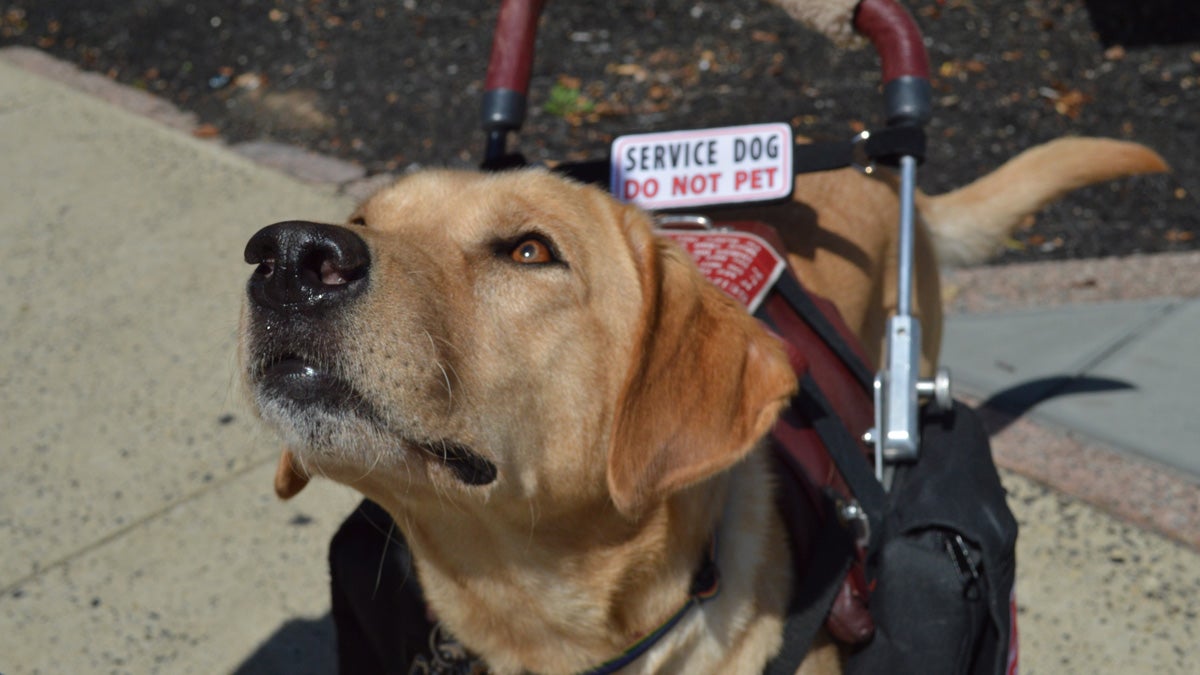Service dog or impostor? Here’s how to spot the difference
Listen
Wynn is a service dog specially trained to detect symptoms that might precede his owner's seizure. (Paige Pfleger/WHYY)
If you have a dog and have to fly for travel, you might feel bad about making your furry companion fly in a crate with the cargo. But if you have about $25, you could perhaps change that.
If you were so inclined, you could buy a service dog vest online, along with a very official-looking card that reads, “I am a service animal, and my right to accompany my handler is protected by federal law”.
I’m, of course, not suggesting you do such a thing. A friend told me about these vests, and it got me wondering if people really turn their pets into fake service animals just to get them on a plane, or into a restaurant. So, I called a couple of veterinarians to see if they had ever come across this phenomenon.
I chatted with Colin Dwyer, a veterinarian in New York City, and he said that he gets asked to certify pets as service dogs all the time.
“I usually tell them I’m not going to lie and put my license on the line just so their dog can sit next to them on a plane,” Dwyer said. “I’d like my dog to sit next to me on the plane, too.”
But even if the vet says no to verifying your dog as a service animal, it is still possible to pass off your 15 year old howling beagle who can barely walk or see as a service dog just by throwing a vest on it.
How is this possible?
Service dogs are doing a lot of new things these days, which has been a boon for people with all kinds of disabilities and health issues. But, as is often true with new and emerging developments, it has also created confusion, loose rules, and opportunities for fraud.
I went to the Penn Vet Working Dog Center in Philadelphia, which is where I met Punches, an adorable one-year old yellow lab. While her peers may be out in the world sniffing the things that dogs sniff, Punches is walking around in a circle, trying to detect low blood sugar.
Punches is one of several dogs being trained here. Her trainer Jonathan Ball is spinning a contraption made from wooden beams that holds four jars containing saliva samples. One of the samples was donated by a person with diabetes and low blood sugar. The other three jars contain normal samples.

Punches is sniffing samples to detect low blood sugar (Emma Lee/Newsworks)Punches keeps getting it right. She’s already been paired up with her future owner, a young woman who comes in a few times a week to get used to having a service dog. Punches will cost her $20,000.
But before Punches leaves the center, she has to learn a lot more than just smelling if her future owner’s blood sugar is dropping. She has to learn how to ride up and down an escalator, how to get in and out of a car, and proper social skills. They can’t react to people coming up behind them, or loud cars going by. They have to remain calm, confident, and most importantly focused on their handler.
New services, new opportunities, new issues
Punches is a part of a new generation of service dogs that is expanding on what help they can provide to humans. In addition to guide dogs, there are now diabetes alert dogs, dogs that help people with Autism and PTSD.
What makes a service dog according to the Americans With Disabilities Act is that the dog is providing specific services to the person they are working with. The ADA only recognizes dogs as service animals, so, a miniature horse does not qualify.
The ADA is also very specific about what is not a service dog. The first thing that is not considered a service dog is — a pet. Sure, they perform the service of loving us, but that doesn’t quite qualify. Therapy dogs are also not considered service animals under the ADA.
“The do a wonderful job of helping people, making them feel better, but they are not service dogs, there is a difference” said veterinarian Cindy Otto, who heads the Penn Vet Working Dog Center.
If your dog does qualify as a service dog, however, they can go anywhere you go.
The federal justice department just clarified and updated the rules related to service dogs. Legally, staff in restaurants, bus drivers, airport workers or others can only ask two specific questions: First, is the dog required because of a disability? And two, what work or task has the dog been trained to perform?
They are not allowed to request paperwork for the dog, or ask specific questions about the person’s disability.
How Wynn helps prevent falls and injuries
Wynn is a yellow lab who has been trained to do a variety of tasks for his owner, Alison Brady. He can pick up her cell phone off the ground and carry it around for her.
“I’ve had three strokes, so I use him for stability. He’s a seizure alert dog, he helps me with my sugars that drop,” Brady explains.

Alison Brady instructs her service dog, Wynn, to stand next to her while she reads a sign. Brady has had three strokes, and Wynn helps her with her stability. (Paige Pfleger/WHYY)
She’s had Wynn since the summer of 2013. He is her third service dog. Her previous two dogs are retired, but still live with her.
“In 2004, I was having about 100 seizures in a month,” she said. “I didn’t know what to do. I just ended up on the ground, and people would walk around me.”
Brady was born with an arteriovenous malformation in her brain, an abnormal connection between veins and arteries that causes seizures. Wynn, and her other service dogs, sense or smell when she is about to have a seizure.
“First he’ll put his paws on my lap, then he’ll put his paws on my chest,” Brady says. ‘It just says, ‘stay’ so before my sugars drop, before I get a migraine, he’s like ‘Hey, you’re going to stay right here.'”
This helps prevent falls or injuries. Brady will sit down right where she is and sometimes, Wynn alerts other people to help her.
The fact that Brady’s disability is not immediately visible has meant that sometimes people have told her she can’t bring Wynn into a store or a restaurant. She was recently confronted by a clerk in a pharmacy who told her she couldn’t bring Wynn inside.
She told the clerk it was her right to bring her dog, and eventually they were both allowed in.
“I don’t like to be difficult,” she said. “I’d rather explain it than get loud.”
Why fakes mean trouble
On occasion, Alison has run into some dogs wearing service vests that she wasn’t so sure about because they didn’t act like service dogs — they were yappy, or out of control, or didn’t seem to have the right training. She doesn’t let it bother her, but others, like Cindy Otto, have a real problem with fakes.
“They are really causing a problem, because their dogs aren’t trained for this. Some of them may be, most of them aren’t and any problems they cause really cause problems for people who rely on these dogs for their life,” Otto said.
There are no federal standards or procedures for certifying a service animal, and people looking for a service dog have to do a lot of research and homework. “Often, the organization training the dog also tests the dog and writes up a certificate,” said Otto. “That is a problem.” Some states have started to regulate training and testing of service dogs, but Otto wishes tighter rules were in place everywhere.
“I definitely believe there needs to be a certification, a way to test the dog. The dog has to achieve certain criteria,” Otto says. “For the sake of the person receiving the dog, I think a certification would be extremely valuable.” She added that search and rescue dogs, bomb squad dogs, and police dogs all have to pass tests before they can start working.
This would not only protect consumers from buying a dog that can’t do its job, Otto explains. It would also perhaps stop pet owners from trying to pass of their howling beagle as a service animal.
WHYY is your source for fact-based, in-depth journalism and information. As a nonprofit organization, we rely on financial support from readers like you. Please give today.




